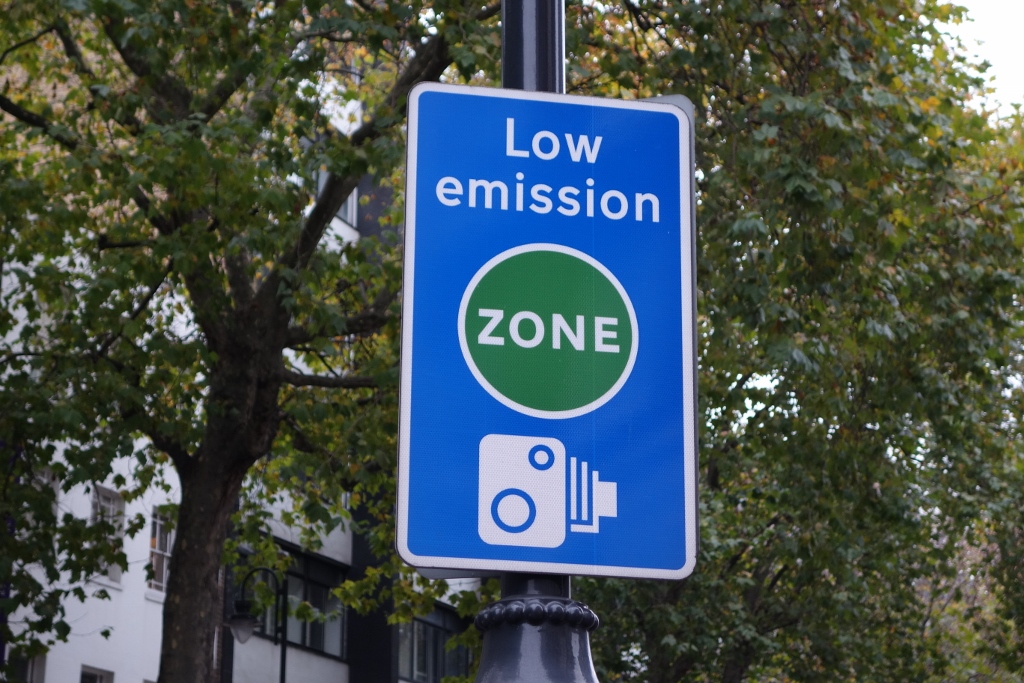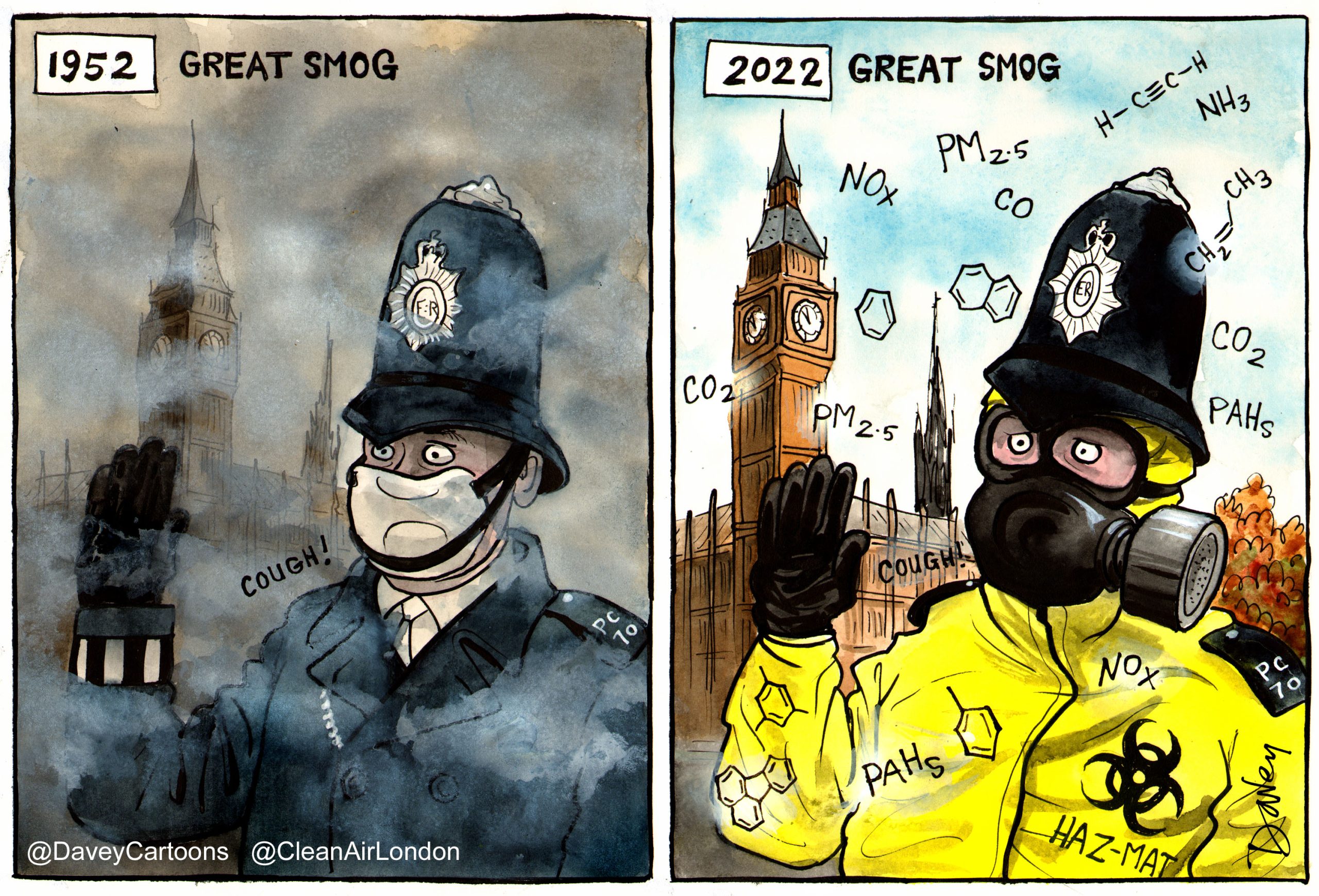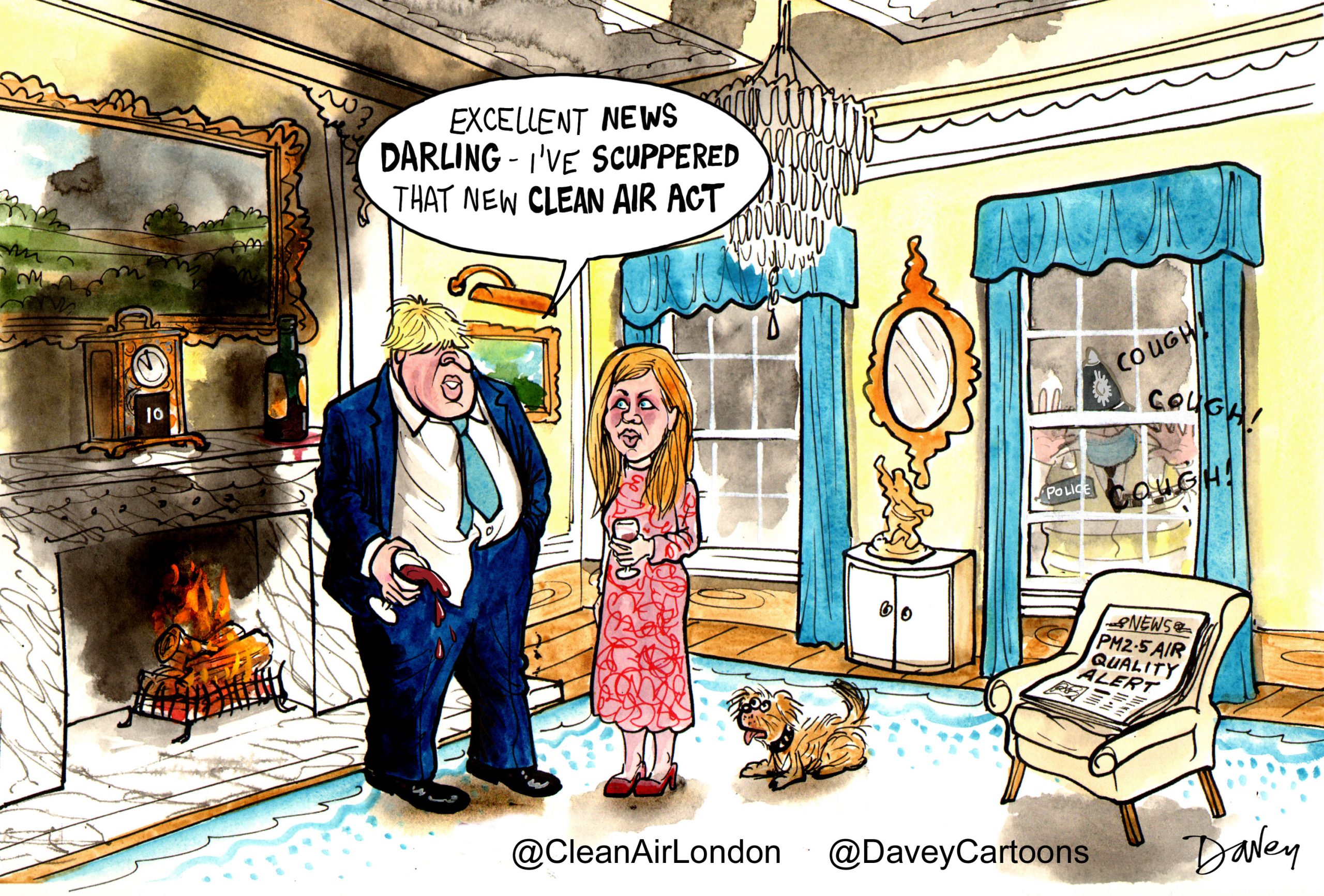Ultra low emission zone: Diesel exhaust is the problem; and banning it is the solution
Transport for London is expected to propose the Euro 6 standard for diesel and the Euro 4 standard for petrol for the Central Congestion Charging Zone in 2020 for all categories of vehicles as part of a wider ‘Air Quality and Emissions Action Plan’
Mayor must stop ‘crying wolf’ in claiming there are technology ‘silver bullets’ based on European engine emission standards. A primary ULEZ should ban all four year old diesel vehicles and all 10 year old petrol vehicles from the area bounded by the North and South Circular roads by May 2018 and all diesel vehicles from that area by January 2020. Secondary ULEZs should tackle the most-polluted other areas e.g. around Heathrow and in east London
London should apply for European structural funds to support the implementation of ULEZ(s)
********** Transport for London survey until Sunday 13 April 2013 **********
https://consultations.tfl.gov.uk/planning/air-quality-survey/consult_view
********************************************************************************
Dear Mayor of London
I am writing on behalf of Clean Air in London (CAL) to respond to the Mayor’s proposal for a so-called ‘ultra low emission zone’ (ULEZ). CAL submitted preliminary views at the meeting of the London Assembly’s Environment Committee on 11 July 2013 (which was attended by Transport for London (TfL)) and at a TfL stakeholder meeting on 14 November 2013.
Background
The Mayor announced plans for an ULEZ on 13 February 2013.
The Mayor said:
“The Mayor of London has announced his intention to create the world’s first Ultra Low Emission Zone in central London, in a move that he believes will deliver dramatic benefits in air quality and provide a major spur for the further development and mass take-up of zero and low emission vehicles. He has asked Transport for London to prepare plans to look at introducing a scheme that would aim to ensure all vehicles driving in the centre of the capital during working hours would be zero or low emission, and the feasibility of introducing such a scheme from 2020.” CAL emphasis.
and
“The Mayor of London, Boris Johnson, said: “Creating the world’s first big city ultra low emission zone has the potential to be a game changing moment in the quality of life of our great capital. My vision is a central zone where almost all the vehicles running during working hours are either zero or low emission. This would deliver incredible benefits in air quality and stimulate the delivery and mass use of low emission technology.”
At the same time the Mayor announced the cancelling of Phase 5 of the London-wide low emission zone from 2015 saying:
“Phase five of the capital’s Low Emission Zone is due to be introduced in 2015 and the Mayor has confirmed it will now only apply to Transport for London’s fleet of buses. By limiting phase 5 of the Low Emission Zone to the TfL bus fleet the Mayor expects to save around £350m in costs for businesses using vehicles that would have been affected by the changes. In today’s speech the Mayor explained how he believes a range of alternative measures can deliver around 200 per cent of the benefits forecast by the original proposal for phase 5 of the Low Emission Zone.”
Minutes before presenting evidence at the London Assembly Environment Committee meeting on 11 July 2013, TfL published the following paper about the ULEZ:
http://www.london.gov.uk/sites/default/files/ULEZ%20scrutiny%20briefing%20-%20July%202013.pdf
http://www.london.gov.uk/moderngov/ieListDocuments.aspx?MId=4966
CAL attended a TfL stakeholder meeting about the ULEZ on 14 November 2013. Details of the event and the main presentation:
CAL’s impression from the stakeholder event is that TfL will propose to the Mayor: the Euro 6 standard for diesel; and the Euro 4 standard for petrol for the Central Congestion Charging Zone (CCCZ) in 2020 for all categories of vehicles as part of a wider ‘Air Quality and Emissions Action Plan’. Such a scheme would be small, weak and probably five years behind leading cities like Berlin. Austria is already implementing a Euro 6 scheme for diesel vehicles.
At the TfL stakeholder event, a show of hands confirmed no-one present considered 2020 to be an ambitious timetable for the ULEZ.
TfL’s presentation highlighted the scale of exceedances of World Health Organisation (WHO) guidelines and legal limits currently expected in 2020:
CAL 264 TfL FINAL ULEZ_2020 only
This map is consistent with the European Environment Agency’s database showing that London has the highest levels of nitrogen dioxide (NO2) of any capital city in Europe.
Submission
CAL urges the Mayor to follow key principles when determining the ULEZ(s).
1. Vision
The Vision stated by the Mayor on 13 February was bold and exciting e.g. ‘deliver dramatic benefits’, ‘major spur for the further development and mass take-up of zero and low emission vehicles’ and ‘ensure all vehicles driving in the centre of the capital during working hours would be zero or low emission’. Such a Vision is close to CAL’s Vision of banning all diesel vehicles from the most-polluted parts of London by 2020 stated on 24 June 2013:
It seems TfL’s Vision for the ULEZ could: be small; be weak; exclude parts of the day; and may exclude several categories of vehicle. CAL considers TfL’s thinking to be far short of the Mayor’s Vision, even ‘lazy’, ‘timid’ and ‘unambitious’.
2. Why have an ULEZ?
The WHO classified diesel exhaust as carcinogenic for humans in June 2012. In October 2013, the WHO went further and classified outdoor air pollution and particulate matter as carcinogenic to humans.
http://www.iarc.fr/en/media-centre/pr/2012/pdfs/pr213_E.pdf
http://www.iarc.fr/en/media-centre/iarcnews/pdf/pr221_E.pdf
The Mayor’s own estimates show that diesel exhaust is responsible for up to 30 times more NO2 and particle exhaust emissions than petrol.
The Mayor’s Air Quality Strategy (MAQS) estimated that road transport is responsible for around 80% of PM2.5 emissions in London.
http://london.gov.uk/priorities/environment/publications/mayors-air-quality-strategy
Public Health England estimates that up to 8.9% of all deaths in London in 2011 were attributable to long-term exposure to human-made PM2.5.
The WHO has published a state of the art assessment of the health impacts of air pollution:
Last but not least, the European Commission is expected to set out a bold vision for action in its ‘package’ for the ‘Year of Air’.
http://ec.europa.eu/environment/air/review_air_policy.htm
Even the Mayor’s own projections to 2020, based on emissions estimates that are likely to be 10% to 30% below real world emissions for NO2 and oxides of nitrogen (NOx), show the ULEZ needs to cover at least 11 inner London boroughs. By substantially underestimating emissions the Mayor may exponentially underestimate benefits.
In CAL’s opinion, the Mayor, TfL and leaders of local authorities should consider themselves culpable for their respective parts in this public health crisis. Please also consider the Mayor’s responsibility under the Public Sector Equality Duty. Why also is TfL prioritising the safety of passengers ahead of the safety of those exposed to emissions from transport where it is the responsible authority e.g. buses, taxis and within the CCCZ and LEZ?
3. Who, What, Where and When?
The Mayor should stop ‘crying wolf’ in claiming there are technology ‘silver bullets’ e.g. the Euro 6 standard for diesel. The problem is diesel exhaust and the solution is to ban it from the most-polluted places. The only questions are who, what, where and when?
CAL proposes two stages for the ULEZ(s):
By May 2018:
The primary ULEZ should set an age limit of four years for all diesel vehicles and 10 years for all petrol vehicles within the whole area bounded by the North and South Circular Roads by May 2018. Other hotspot areas might become secondary zones e.g. around Heathrow and in east London.
The ULEZ(s) might be implemented as an age limit or implemented through a requirement applying the Euro 6 standard for diesel and the Euro 4 standard for petrol. Please however do not confuse the setting of such a Euro engine standard as a technology solution – instead it would simply be a blunt instrument for banning the oldest vehicles i.e. most cheaply.
CAL understands that Berlin is considering tightening its existing low emission zone, which covers the most-polluted 30% of the city, to Euro 6 for diesel and Euro 4 for petrol by 2015. Berlin’s existing scheme has ‘small inputs’ and ‘big outputs’ and targets the most-polluted areas rather than imposing unnecessary burdens on those entering the relatively cleaner outer areas of the city. Austria is already implementing its first Euro 6 based low emission zone.
London’s ULEZ(s) should follow the Berlin model of stickers and points on a driving licence not a gold-plated camera-based scheme. See:
http://www.lowemissionzones.eu/
http://www.lowemissionzones.eu/countries-mainmenu-147/germany-mainmenu-61/berlin
By January 2020:
A primary ULEZ should ban all diesel exhaust from the whole area bounded by the North and South Circular Roads by January 2020.
The Mayor should follow his ‘Vision’ and be bolder still, fundamentally re-engineering London and tackling the short and long-term challenges, instead of taking successive backward steps. Any exceptions should be limited to those people and vehicles for which there is a genuine need and no other alternative is possible.
4. Mayor’s track record with road schemes is awful
CAL regrets that the Mayor’s track record on similar schemes has been very poor. For example:
i. delaying Phase 3 of Mayor Livingstone’s low emission zone from October 2010 to January 2012;
ii. scrapping the western extension of the congestion charging zone despite adverse air pollution impacts expected;
iii. 100% discount for diesel vehicles entering the CCCZ i.e. Greener Vehicle Discount that was recently scrapped because of the problems it created;
iv. scrapping Phase 5 of the Mayor’s LEZ other than for buses; and
v. numerous other backward steps on air pollution e.g. scrapping the Mayor’s own proposal for a 10 year age limit for taxis.
Please implement one or more bold two-stage ULEZs not take more backward steps.
5. Don’t confuse, costs, benefits and outputs
TfL consistently focuses more on its own costs and convenience than the benefits of ambitious schemes for: public health; green businesses; transformational change; and the avoiding of EU fines for failing to comply with limit values.
TfL also muddles inputs and outputs, for example, considering the compliance rate for the current LEZ as an output not an input. Please do not claim emissions standards hit the poorest hardest – the simple fact is that the poorest, most vulnerable people have air pollution not vehicles.
CAL understands the latest estimate is that air pollution ‘costs’ London about £2.5 billion per year. Currently, the Mayor seems to be considering solutions that are one or two orders of magnitude less than the problem.
Berlin and New York have shown convincingly that the assessment of real world emissions and concentrations to identify the source of the most harmful pollutants can lead to the successful implementation of practical and effective measures.
6. Computer modelling
The Mayor’s modelling keeps focussing on NOx instead of NO2 for which WHO guidelines and legal limits exist. CAL considers that the London Atmospheric Emissions Inventory 2010 is likely to underestimate emissions of NOx and NO2 by between 10% and 30%. Please base ULEZ projections on the latest evidence of real world emissions as shown by Carslaw et al:
TfL’s modelling should include the benefits of behavioural change not just technology and other costs e.g. travel cost savings and health benefits from modal shift. At a minimum, the Mayor’s proposals for the ULEZ(s) need to be sufficient to ensure – with any other measures – full compliance with air pollution laws throughout London.
7. Real world testing of emissions
Please back any emissions schemes the Mayor introduces with roadside real world testing of emissions as is commonplace in a city like Denver, Colorado. CAL considers it likely for example that the next generation of petrol vehicles will need particle filters fitted before 2020. See:
http://www.transportenvironment.org/publications/particle-emissions-petrol-cars
Such testing could identify problems at an early stage and the need for further measures.
8. Use the ULEZ area(s) to catalyse change
Carrot and stick are both needed to tackle London’s air pollution problems if the city is to lead the world again as it did after the Great Smog of 1952 and the Clean Air Act of 1956.
Please use the ULEZ area(s) to tighten emissions standards generally and catalyse other benefits across London and more widely e.g. as a focus for tighter controls for non-road mobile machinery (NRMM), taxis and buses.
Please incentivise change and provide alternatives e.g. by building public understanding of air pollution and investing in ‘rapid’ charging for electric vehicles (i.e. 30 minute battery charging for cars, taxis and vans) and high return on investment cycling schemes like that implemented by Camden Council in Royal College Street and by the City of London and now being considered by the City of Westminster.
The Mayor should listen to Commissioner Potočnik who said recently:
“LIFE will also support a series of large scale integrated projects designed to improve air quality compliance and leverage access to other funding sources. I also wish to see cities and regions maximising the use of EU funds to promote fuel switching in those areas where domestic solid fuel is still a major problem, and new mobility initiatives to reduce transport impacts. Much of the structural funds go unused, even though areas with the biggest air quality problems often have the most preferential access, with co-funding requirements as low as 15%.”
London should apply for these structural funds to support the implementation of ULEZ(s) and related measures e.g. for taxis, buses, NRMM etc.
Please stop hiding air pollution and ban diesel exhaust in two stages to 2020 as coal burning was banned some 60 years ago.
CAL would be pleased to discuss these proposals with the Mayor or his team.
Yours sincerely
Simon Birkett
Founder and Director
CAL 264 TfL FINAL ULEZ Stakeholder event MD slides STATIC 141113
CAL 264 TfL ULEZ stakeholder briefing 030314_TfL’s FINAL SLIDES
CAL 264 TfL ULEZ scrutiny briefing 130713
CAL 264 ULEZ – Update Feb and March 2014
CAL 264 GLA breakdown of NO2 by borough to 2020 based on LAEI 2010
CAL 264 LAEI 2010_NO2 exhaust emissions_Draft 270214
CAL 264 LAEI 2010_NO2 exhaust emissions_Draft 010314_All London Zones
CAL 264 LAEI 2010_NO2 exhaust emissions_Draft 010314_Central London Zone
CAL 264 LAEI 2010_NO2 exhaust emissions_Draft 010314_Inner London Zone
CAL 264 LAEI 2010_NO2 exhaust emissions_Draft 010314_Outer London Zone
CAL 264 LAEI 2010_NO2 exhaust emissions_Draft 280214_Camden
CAL 264 LAEI 2010_NO2 exhaust emissions_Draft 010314_City of London
CAL 264 LAEI 2010_NO2 exhaust emissions_Draft 280214_Islington
CAL 264 LAEI 2010_NO2 exhaust emissions_Draft 010314_RBKC
CAL 264 LAEI 2010_NO2 exhaust emissions_Draft 0101314_Westminster
CAL 264 B.3 Grid Summary By Vehicle Type_Zones 2012
CAL 264 B.1 Grid Summary By Source – CO2 and NOx_2012
CAL 264 B.2 Grid Summary By Source – PM10 and PM2.5_2012
CAL 264 TfL presentation re ULEZ options 030314_6 MB file size_Note pages 25-28 repeated
CAL 264 GLA presentation to Fitzrovia BID_Breathe Better Days is ‘Solutions 4’ on page 8
CAL 263 GLA regulatory asks of DfT 2014
CAL 264 T and E RDE – a last chance for diesel cars FINAL 300914
CAL 294 ULEZ Supplementary information_Final 291014
CAL 294 NO2 annual mean 2020 map_per ULEZ
CAL 294 ULEZ HIA_Final_ULEZ consultation_Reduced size
CAL 294 ULEZ IIA report_Final_ULEZ consultation
CAL 294 ULEZ IIA economics and business_Final_ULEZ consultation










